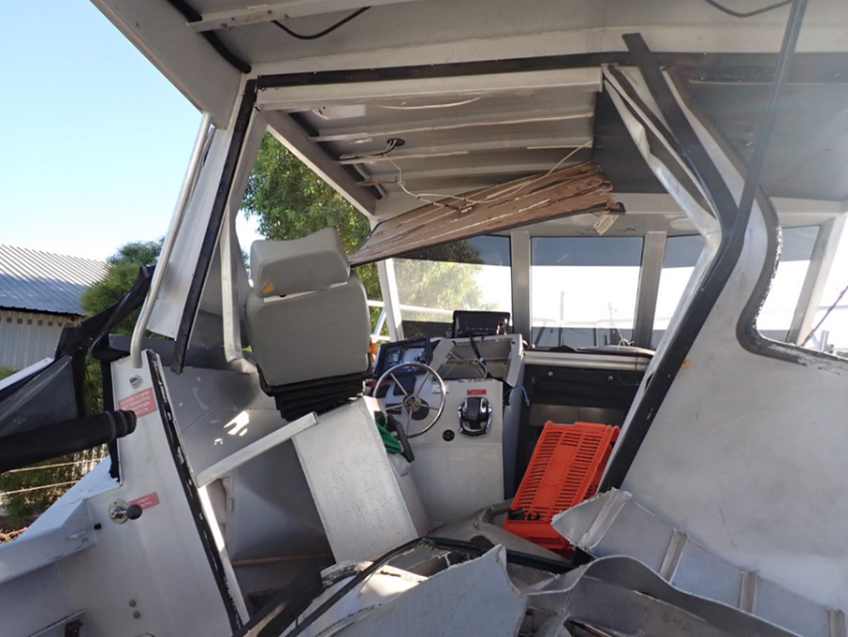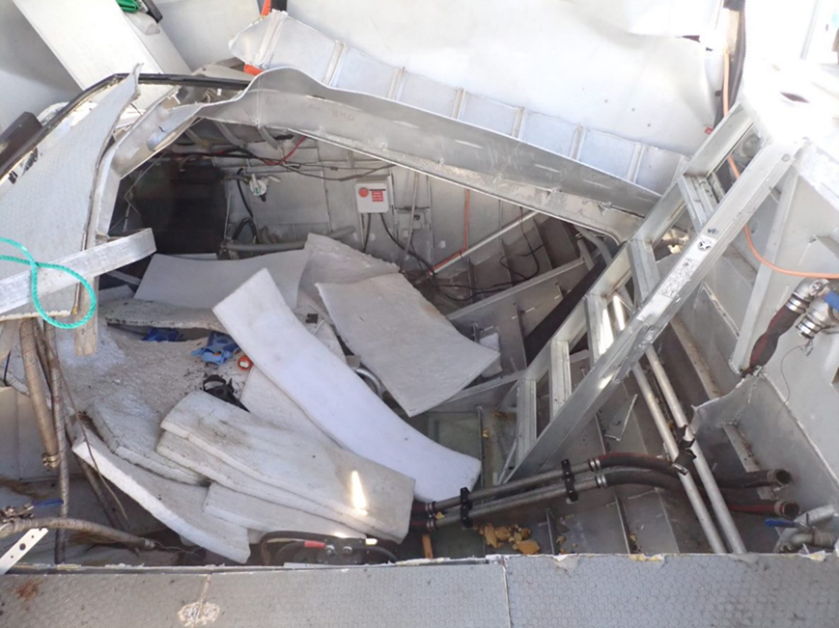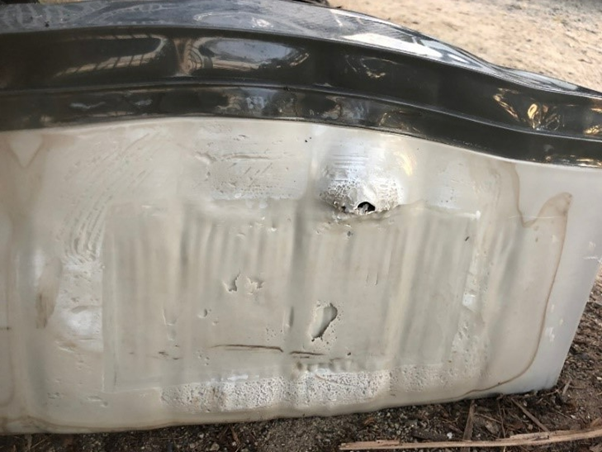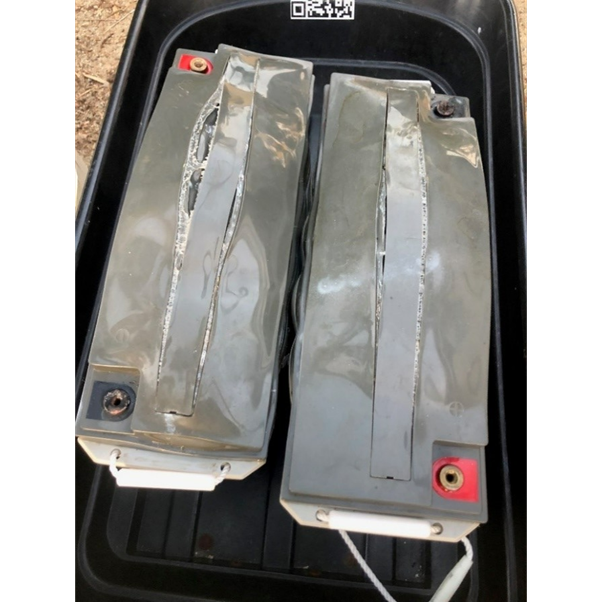This edition outlines an upcoming campaign on plan approval documentation and fire safety, initial survey recommendations and more.
In this edition
- Focused certification campaign 2023-24
- Guidance for recognised organisations making initial survey recommendations
- Electrical matters
- Updates to Exemption 44
- NTSB Report – doubler-plated hull repairs
- Changes to operational safety requirements
Focused certification campaign 2023-24
AMSA will conduct a focused certification campaign for the 2023-24 financial year, focusing on plan approval documentation and fire safety.
As mentioned in the November 2022 edition of Survey Matters, incomplete survey process and fire safety non-compliance are two significant reasons for refusal of certificate of survey applications.
The campaign will see AMSA conduct focused assessments on high-risk vessels, to confirm structural fire protection (SFP) and fixed firefighting systems are compliant, as well as reviewing plan approval letters in greater detail.
Plan approval letter content
The saying "failing to plan is planning to fail," rings true in the context of design appraisal in the maritime industry. As stipulated by the Surveyor Manual (SAGM Part 2), plan approval letters play a pivotal role in maintaining safety, compliance, and transparency throughout the survey process. For new construction and modification projects, these documents facilitate a smooth and streamlined process.
Despite their significance, AMSA frequently receives plan approval recommendations that lack the necessary plan approval letters or inadequately describe the applied standards or survey processes. This causes delay in application processing, adversely affecting your customers.
Plan approval letter(s) must comprehensively describe the process applied to the vessel, including the applicable standards, examined drawings, scope of your plan appraisal, comments, and outcomes. For transitional vessels, please specify the vessel changes that invoke the transitional standards. The SAGM Part 2 clause 3.9.2. provides the requirements for plan approval documentation.
Before submitting your plan approval letters, ask yourself: Could a third party with no background knowledge of the vessel comprehend the entire process you have applied? Or would they conclude that only a partial survey, such as an NSCV C3 or machinery NSCV C5A review, has been conducted?
Ensure your plan approval letters are clear and thorough. This reduces the likelihood of an incomplete survey process and enhances the vessel certification process.
Fire safety items
Fire is a serious issue that can lead to catastrophic results. In 2021 the US passenger vessel Conception caught fire resulting in the total loss of the vessel and the loss of 34 lives.
Design controls such as fire detection, alarm, fire protection and escape and evacuation routes may have prevented this tragedy. An investigation of the event found that the escape and evacuation routes and alarm systems did not enable persons to escape from their sleeping quarters before the fire developed.
Similarly in Australia, significant fires have occurred in the last 5 years which resulted in total vessel loss. For example, the catamaran vessel 1770 was a total loss after an engine room fire. Investigations concluded that incorrect fitment of structural fire protection allowed the fire to spread through the vessel’s tunnel to an adjacent space. Whilst this event did not result in the loss of lives, 19 persons were hospitalised.
The April 2020 and September 2021 editions of Survey Matters provided a detailed analysis of AMSA’s requirements for structural fire protection onboard vessels of steel, aluminium, and composite construction, as well as the expected documentation to support recommendations.
In addition to the provision of structural fire protection, many vessels are required to be fitted with fixed fire-extinguishing systems. As part of the focused certification campaign, AMSA will be expecting confirmation that the fixed fire-extinguishing systems conform to the acceptable standards outlined in Table 14 of NSCV Part C Section 4.
Guidance for recognised organisations making initial survey recommendations
When a vessel is classed with a registered organisation (RO) and intends to operate as a domestic commercial vessel (DCV), an application for a certificate of survey is required. The operator will be sent a letter containing a list of surveys which are to be completed and recommended by an Accredited Marine Surveyor (AMS) or an RO surveyor.
While documentation that shows a vessel was built in accordance with class rules demonstrates compliance with some aspects of the National Law, it does not cover all the requirements. The owner must ensure the aspects that are not covered by its certificate of class are surveyed. An owner can employ an independent AMS to survey those aspects on vessels less than 35m long, however it is common for the RO to complete all the initial surveys for a vessel.
Further information and detailed instructions can be found in Chapters 3 and 5 of the Marine Surveyor’s Accreditation Guidance Manual (SAGM) Part 2 or via the initial certificate of survey applications page on the AMSA website.
What is covered by a certificate of class?
A certificate of class is accepted by AMSA as evidence that the vessel complies with the following aspects of initial survey:
- Hull structure (NSCV Part C3)
- Machinery (NSCV Parts C5A, and C5C*)
- Electrical (NSCV Part C5B*)
- Anchoring (NSCV Part C7D)
*There are state laws relating to electrical and LPG systems that apply to domestic commercial vessels. For some installations a state certificate of compliance is required. It is therefore recommended to have electrical installations (LV and above) and LPG installations inspected by a suitably qualified and licensed technician within Australia, and to submit any reports and certificates as part of the initial survey application.
What is not covered by a certificate of class?
The following parts of the NSCV need to be specifically addressed as they apply to the vessel for plan approval, construction, and commissioning phases of initial survey, in addition to the classification component above.
Arrangement, accommodation, and personal safety (NSCV C1)
The requirements of NSCV C1 are often missed by ROs in the plan approval survey, as they are not covered by a certificate of classification. NSCV C1 includes requirements for bridge visibility, navigation lights, passenger and crew accommodation, stairways and ladders, escape and evacuation routes, and personal protection, amongst other things. It reflects statutory requirements drawn from a number of international conventions and other legislation and forms an essential part of the NSCV.
The initial plan approval (PLAN) survey will need to address NSCV C1 requirements. The general arrangement, navigation light, fire & safety, and other arrangement drawings should be assessed by a plan approval surveyor for compliance. Reference to the C1 standard must be included in the plan approval letter submitted with approved copies of the drawings as per SAGM Part 2 Chapter 3.9.2.
Watertight and weathertight integrity (NSCV C2)
NSCV C2 (Watertight and Weathertight Integrity) came into force on 01 January 2023, however there will be a transitional period of 3 years allowing initial survey vessels to comply with either NSCV C2 or the USL Code sections 5C, 5D and 7. The initial watertight and weathertight integrity (IWWI) survey will need to address NSCV C2 or equivalent requirements.
For vessels ≥ 24 metres that would otherwise be subject to the requirements of the International Convention on Load Lines, AMSA will accept a previous international load line certificate or a document of compliance as evidence that the vessel complies with the domestic standard. In such cases, a copy of the certificate or document of compliance, and a copy of the record of conditions of assignment should be submitted as supporting documentation.
Fire safety (NSCV C4)
While class rules may address fire safety, and form part of any new construction or transfer of class surveys, a certificate of class is not accepted by AMSA as evidence that the vessel complies with NSCV C4 (or the relevant marine order, dependent on vessel size). The initial plan approval (PLAN) and initial fire (IFIR) surveys will need to address NSCV C4 requirements for passive and active fire protection, additional measures relating to machinery, accommodation, galley, control, cargo, ro-ro, and helideck spaces, and dangerous goods (as applicable).
Particular attention should be paid to structural fire protection requirements, as these may differ to other national or international standards. The vessel’s structural fire protection and fire & safety drawings should be assessed by a plan approval surveyor for compliance with the standard. Reference to the standard must be included in the plan approval letter submitted with approved copies of the drawings as per SAGM Part 2 Chapter 3.9.2.
Stability (NSCV C6A, C6B and C6C)
As with fire safety, class rules may have requirements relating to stability that form part of the new construction or transfer of class surveys, however a class-approved stability book is not automatically accepted by AMSA as evidence that the vessel complies with the three parts of NSCV C6. The requirements for intact stability (C6A) and damaged stability (C6B) differ from those of the Intact Stability (IS) Code and other conventions that relate to intact and damaged stability. For this reason, the vessel’s stability characteristics should be assessed by a plan approval surveyor for compliance with the NSCV, and reference to the standards included in a plan approval letter submitted with a copy of the approved stability book.
Safety, navigation, and communication equipment (NSCV C7A, C7B and C7C)
The installation of safety, navigation and communications equipment as required in the NSCV (or the relevant marine order, dependent on vessel size) is usually confirmed by the attending surveyor when undertaking the commissioning survey (COMM). The equipment to be carried will depend on the number of persons onboard and the operational area of the vessel and may differ to international convention requirements. Please note that the maximum number of persons that can be carried onboard (as shown on the certificate of survey) and the area of operation may be limited by the provision of equipment, therefore it is important that the surveyor who completes and recommends the commissioning survey understands what the proposed domestic operations are.
What documentation to submit to AMSA?
The Marine Surveyor’s Accreditation Guidance Manual (SAGM) Part 2 Chapter 5.4 gives a list of documents to be submitted by an RO to cover those aspects for which classification is accepted, i.e., hull structure, machinery, electrical, and anchoring.
For aspects that are not covered by classification, the list of plans and supporting documents given in Chapter 3.9.2 and Table 2 can be used as a guide. A plan approval letter that addresses the parts of NSCV C1, C2, C4, and C6 that apply to the vessel, and referring to the relevant vessel plans, must be submitted with copies of the approved plans and documents.
Which AMSA forms to complete?
AMSA has produced forms that relate to each survey code to enable easier reporting of surveys. Annex 1 of SAGM Part 2 gives a reference table of forms that relate to each survey code. The forms can be downloaded from the AMSA website here.
Surveyors may also make their recommendations on their own equivalent forms if all the same information is provided.
How to submit?
Surveyors from recognised organisations can arrange for access to the MARS online system by contacting OSS@amsa.gov.au. MARS enables surveyors to upload survey reports and supporting documents directly to AMSA resulting in applications being processed faster.
AMSA no longer uploads reports on behalf of surveyors, other than for electrical surveys. If the RO is submitting electrical survey reports on behalf of a licensed electrician, these can be emailed directly to dcvapplications@amsa.gov.au.
Electrical matters
Vessel explosion
In December 2022 an explosion occurred on the vessel pictured below while at anchor. The explosion may have been caused by lithium-ion batteries reaching thermal runaway within an enclosed space.
Fortunately, no one was onboard at the time and no injuries were reported.
You can read more about lithium batteries and the associated hazards in the January 2020 edition of Survey Matters.


Overcharged lead acid batteries
The batteries pictured below were recently removed from a sailing catamaran after the owner noticed strange things happening with the vessel’s power.
The electrical surveyor reported that an incorrect charger was being used and the batteries were constantly left on charge.
As well as the batteries being replaced, the charger was replaced with one suited for maintenance charging.


Extra low voltage solar photovoltaic (PV) systems
WorkSafe QLD recently published an article about the risks of working on solar PV systems following the electrocution of a person modifying solar panels on an off-grid system.
Read the eSAFE article on the WorkSafe QLD website for more information and issues to consider.
UK Maritime and Coastguard Agency guidance – Small electric powered craft on yachts
Following an increase in fires on yachts, The United Kingdom Maritime and Coastguard Agency has published a guidance notice regarding fire safety and storage of small electric powered craft on yachts.
The guidance is available on the UK MCA website here.
Updates to Exemption 44
A revised Exemption 44 – Marine Safety (Domestic commercial vessels – EIAPP Certificate) 2023 (EX44) has been published.
EX44 exempts DCVs from the requirement in Marine Order 503 to hold an Engine International Air Pollution Prevention (EIAPP) Certificate to be issued a certificate of survey.
It is important though to note that EIAPP certificate requirements still apply to some DCVs through Marine Order 97 (MO97). MO97 requires DCVs to have on board an EIAPP certificate and associated Technical File for each marine diesel engine over 130kW that is installed or that undergo a major conversion after 31 December 2022. However, this requirement is not linked to the criteria for a DCV to be issued with a certificate of survey.
AMSA is writing to Australian marine diesel engine suppliers to strongly urge them to secure the required certification prior to the importation of engines to Australia, where relevant, and otherwise at the time the engine is tested by the manufacturer for NOx compliance. This will help avoid unnecessary delays and costs.
NTSB Report – doubler-plated hull repairs
The United States National Transportation Safety Board (NTSB) recently released its report into the loss of the fishing vessel Grace Marie in July 2022. The report focuses on the failure of the doubler-plated hull under the engine room as the likely cause of the incident. The 7 crew members on board were rescued and no injuries were reported; however, the total loss was valued at $650,000.
The full report is available via the NTSB website.
Changes to operational safety requirements
On 1 August 2023, a series of changes to Marine Order 504 (Certificates of operation and operation requirements) came into force which follow extensive consultation with industry to improve operational safety outcomes.
The changes broadly relate to risk assessment – in particular, the wearing of lifejackets, crewing and safety management system requirements under Marine Order 504.
While these changes won’t impact the important work of accredited marine surveyors, they may come up in conversation with domestic commercial vessel owners and operators.
As such, please encourage vessel owners and operators to seek guidance from AMSA’s information hub.
Below is a summary of the changes:
- Crewing provisions will better align with the certificate of competency arrangements in the revised Marine Order 505 (Certificates of competency) which came into force on 1 January 2023. The minimum crewing requirements table in Marine Order 504 has also been simplified.
- Sufficient rest (a minimum of 10 hours in every 24-hour period) must be adequately addressed when determining risk-based crewing levels.
- Risk assessment (including the appropriate crewing determination) must be accessible to the master, crew and marine safety inspectors.
- The master and crew (if applicable) must be consulted on the development of the vessel’s risk assessment.
- A copy of the vessel’s safety management system must be kept onboard (if practical) and with onshore personnel.
- Additional onboard training and drills will become a requirement for emergency procedures which must be addressed in the vessel’s safety management system, and associated record-keeping must be undertaken.
- There must be clear and direct reporting pathways for the escalation of issues to the designated person, these must be understood by crew and master and incorporated into the safety management system, which must be working as intended.
- Lifejacket wear must be addressed in the vessel’s risk assessment and a written procedure must be included in the safety management system.
Vessel owners and operators should be encouraged to review and reassess their safety management system, crewing determination, and risk assessment to ensure they meet the new requirements.
Please refer vessel owners and operators to the information hub on AMSA’s website where they can find examples, checklists and step-by-step guidance.